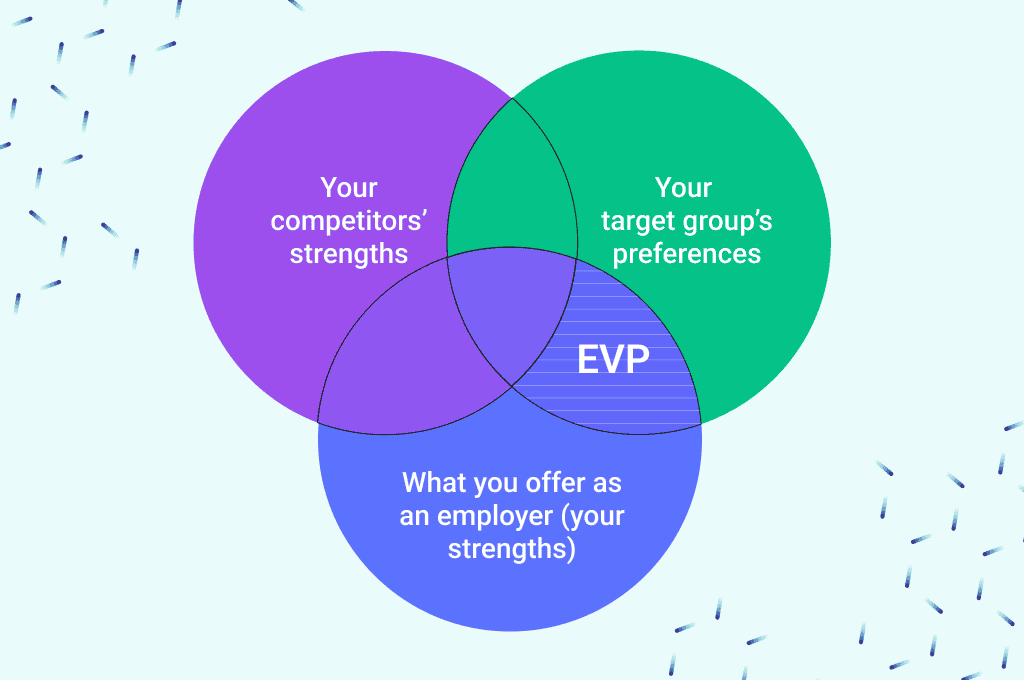Employer branding is one of those business practices that is popular yet doesn’t have a conventional strategy for implementation. However, certain things are useful to pay attention to for an awesome employer branding strategy. This is part of an extensive series of guides about workforce management.
Table of Contents
ToggleEmployee Value Proposition (EVP)
The main focus of your employer branding is to understand what your company offers to employees, what your competitors provide to employees, and what your target group wants. Hence, you will market the benefits that employment in your company offers, which competitors do not have, and that your target group wants. This is called the employee value proposition (EVP). For a simple illustration, here is a Venn diagram taken from a slide presentation created by Armin Trost, a leading mind in HR.

This is a very similar approach to corporate branding’s unique selling point (USP), but for recruitment, and more tricky. This is tricky because it turns out that your business concept should also appeal to potential and current employees. Therefore, for the entire process to work out, your offering as an employer should not be disconnected from your overall business objective. Your EVP can differ by job, but with this in mind, they should be similar.
Interdepartmental Collaboration
The beauty of employer branding is that the entire team has to get involved with the process. It is not up to a single department to craft a strategy and implement it. Just like it is important to maintain product integrity when selling products and services to consumers, it is very important that the realities of the workplace experience are highlighted. The HR team may hence need to spend time with the different departments of the workforce to absorb input and opinion by asking the relevant questions, and really dig deep to interpret a desirable EVP. As the HR team determines the appropriate messaging, it may also need to collaborate with the marketing team to come up with and implement strategies for marketing the messaging. Generally speaking, employer branding requires engagement from the entire team, and it is important to establish facile interdepartmental communication to get the entire team on board.
Company Culture
Pivotal to employer branding, it is important to build and preserve a robust company culture. With company culture, it is the company’s reputation as an employer that is the focal point. Just as it is important for the candidate’s experience in the recruitment process to be great, it is important for the experience as an employee to be great, as candidates believe that their experience applying for the job is representative of the experience working for the employer.

As your messaging is going to be based on the real benefits your employees are realizing working for you, try to increase these benefits reasonably, and in the meantime, your employer branding will also grow organically through word of mouth. It can be said that the company culture is to your employees as the product is to your customers. Develop your company culture just as you develop your product, and position yourself in the labor market as a company job-seekers want to work for.
Showing Your True (And Vibrant) Colors
The primary places to include your messaging for your employer brand are in your job advertisements. With online job boards, you can link applicants to your career website, where you can include visuals, articles, testimonials, photos, and videos to showcase your company culture. For example, recruitment software for staffing agencies, like Hirebee, makes it easy to build your career page and link it to your job posts. This software, designed to manage all or most recruitment processes, includes a career page builder tool, which lets you include all the aforementioned content and create an awesome, branded career page. The EVP can also be included in the job description.

But outside of establishing your employer brand in your job advertisements, you should also consider marketing your employer brand elsewhere. Being active on social media, sharing employee stories, writing blogs on your company’s achievements, and being active on employer review sites, where you promote positive reviews and respond to negative reviews to understand what went wrong, are some marketing strategies to consider.
Ultimately, there are many different ways to market your workplace, develop your company culture, and implement your employer branding strategy. But as there is a lot of room for creativity and no clear-cut formula to employer branding success, there are still employer branding fundamentals we want you to pay attention to.
Employee Advocacy Programs
In the symphony of employer branding, one of the most resonant notes comes from within – your employees, a group of enthusiastic voices sharing their genuine stories about your company across all social media platforms. This is the effect of employee advocacy programs. Empower your team to become the representatives of your employer brand. Encourage them to share their journeys, experiences, and the reasons they’re proud to be a part of your organization. These authentic stories serve as testimonials that potential candidates can truly connect with.
Virtual Reality (VR) Tours
Virtual Reality is another way of stepping into the future of employer branding – a realm where potential candidates can explore your workspaces and culture even before stepping through the physical door. Virtual Reality tours offer an immersive journey, a backstage pass to the vibrant tapestry of your company. Imagine candidates donning VR headsets and embarking on a guided tour, virtually walking through your offices, witnessing team interactions, and absorbing the energy of your workplace. This cutting-edge approach to employer branding transcends the limitations of conventional media, offering an intimate encounter that transcends geographical boundaries. Potential candidates can catch glimpses of themselves as part of your workforce, even before applying.
Leadership Spotlight
A Leadership Spotlight initiative offers potential candidates a glimpse into the minds behind the company’s strategies, the passion driving its vision, and the personalities shaping its culture. Through short, engaging video interviews or insightful articles, you unveil the personas that guide your company through difficulties. They delve into the motivations, values, and aspirations that make your leadership team tick. Potential candidates can connect the dots between their aspirations and the shared goals of the company. As the faces driving the organization come alive, candidates begin to see not just a workplace, but a community led by individuals they can respect and resonate with. In this spotlight, leadership becomes a vibrant, accessible force that welcomes potential candidates into the company narrative.









